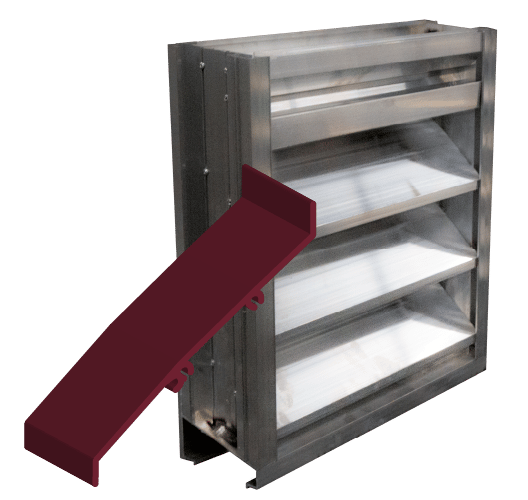In this article, we cover three common types of louvers and what they do in your HVAC system. Learn more about louvers on the MCDLG Newsstand.
The Design Choices Behind Intake Louvers
All louvers serve a key role in your building. Manufacturers create most louvers for specific applications, such as protecting ventilation points from light rainfall, blocking sightlines, or screening out direct sunlight. Louvers will always attempt to balance protection against air flow. In HVAC terms, this is the balance between water penetration protection and air performance.
.webp?width=606&height=238&name=EA662HSL-multiple%20(Resize).webp)
There is a louver for every application. Louvers can meet any requirement and any application, but you may find common applications when preparing for a project. Here are three common intake louvers used to fulfill standard roles in HVAC.
Need some intake louvers for an upcoming project? Arrow United Industries can help. We make each louver to order, ensuring it perfectly fits your needs. Contact Arrow United today and let's work together on meeting your airflow requirements.
#1 Stationary Straight Blade Louver for Ventilation
-1.webp?width=477&height=399&name=MCDLG%20Blog%20-%20Stationary%20Straight%20(Resize)-1.webp)
This is the standard for louvers: straight blade profile, flat and featureless blades, no drain troughs. The design of these louvers prioritizes air performance. Their straight blades have a smooth profile that allows air to flow across with minimal drag. Fans can easily draw air through the louver.
Straight blade louvers provide the basic level of weather protection. The louver blades will slope at a specific angle to naturally reject infiltrating water. All louvers will block a certain amount of rainfall with this design, but the exact level of protection will vary from louver to louver.

If air performance is the top priority, choose a louver with the fewest blade features. Check the louver's percentage of free area as well. This will determine the amount of space between blades. More free area will typically mean better airflow. For more pointers on air performance, read our quick Condenser article here.
Manufacturers can tailor stationary straight blade louvers to match your project. There are many accessories and options, including sill extensions and subframes, to enhance the louver’s functionality. Keep your HVAC system running at a peak performance with louvers built for airflow.
Stationary straight blade louvers are the standard. However, you may need a severe weather louver if you expect heavy rainfall or wind driven rain.
For more on louvers, check out these other Newsstand articles:
#2 Severe Weather Louvers with Chevron Blades for Advanced Weather Protection
.webp?width=516&height=400&name=MCDLG%20Blog%20-%20Severe%20Weather%20(Resize).webp)
When preparing for storm season is the top priority, you need louvers that are built and tested for severe weather protection. These louvers reject the most rainwater. Severe weather louvers will have drain troughs along the face side of the blade, drain channels in the jambs, and a drain pan at the sill.
These components collect the rainwater captured by the blade's profile and drain it out of the louver. Severe weather louvers often use chevron blades to prevent excess rainwater from infiltrating the louver.
Chevron blades have a central curve that allows air to pass over the peak of the blade while heavy moisture stops at the slope. Catches along the blade profile work to capture moisture as air passes by and keeps it from infiltrating the louver. Chevron blades provide a balance between water penetration protection and air performance. Many consider chevron blades the best option for weather protection.
.webp?width=500&height=551&name=MCDLG%202022%20-%20Blades%20Chevron%20(Resize).webp)
An AMCA-approved laboratory must test severe weather louvers to meet requirements. AMCA testing ensures that each intake louver performs under published data. Louvers that undergo these tests will receive an AMCA seal with the relevant ratings listed. Severe weather louvers provide advanced protection from rainfall, including wind driven rain. Read more about wind driven rain testing on the Newsstand: AMCA Testing - Wind Driven Rain
#3 Adjustable Louvers with Baffle Blades for Air Control and Weather Protection
.webp?width=384&height=400&name=MCDLG%20Blog%20-%20Adjustable%20(Resize).webp)
It is common to close off ventilation openings when they aren’t in use, to keep out snow or other debris. Most projects achieve this by installing a control damper behind the louver. To save space, you can use an adjustable louver or a combination adjustable louver. Electric actuators can automatically close adjustable louvers when the intake or exhaust process is complete.
Combination adjustable louvers will have adjustable and stationary blades. The stationary blades are on the face side of the louver while the adjustable blades are behind the stationary blades.
.webp?width=300&height=355&name=EA64C%20-%20Combination%20Adjustable%20Hurricane%20Louver%20(Resize).webp) This is a combination adjustable louver. It keeps the look of a louver, even when the blades are closed.
This is a combination adjustable louver. It keeps the look of a louver, even when the blades are closed.
These louvers maintain a louvered look when the adjustable blades are closed. Their blades can prevent water from infiltrating the louver even in a fully open position. A baffle blade profile can help improve the louver's water rejection capabilities.
Baffle blades have a raised step near the back of the blade. This step creates a catch that captures excess water as air passes over the blade. Baffles blades can have more catches across the blade profile to capture more water. Drain troughs along the face side will channel captured water out. When the blades are fully open, the drain troughs will align with drain channels in the jambs. From there, they work the same way as stationary drainable blades.
.webp?width=600&height=353&name=Hubspot%20Blog%20-%20Baffle%20Blades%20-%20Blades%20(Resize).webp) Examples of baffle blades. Note the raised step on the blade profile. This can help the louver capture rainwater before it can infiltrate into the duct.
Examples of baffle blades. Note the raised step on the blade profile. This can help the louver capture rainwater before it can infiltrate into the duct.
Adjustable louvers with baffle blades protect against rainfall, especially those with drain troughs. To learn more about louver blades, read our primer article: Louver Blades - A Primer.
Adjustable and combination adjustable louvers can receive drain pans and screens, like their stationary counterparts. They can also receive an actuator to control opening and closing the louver's blades. Automate your louver by adding an electric or pneumatic actuator.
Adjustable louvers are the best choice for ventilation and air control in one unit. These louvers are a good option for when you need weather protection and a means to close off a ventilation opening.
.webp?width=606&height=307&name=MCDLG%20Blog%20-%203%20Types%20-%20Combined%20(Resize).webp)
Ventilation will always be important to your HVAC system, and many projects will call for some form of weather protection. Louvers can fulfill many distinct roles in your building, but there are common requirements between projects. You should always design a louver to fit its intended application. You may find common applications that call for these common louvers.
Need help on an upcoming HVAC project? Contact MCDLG today. We are ready to help you.
.webp?width=91&height=70&name=MCDLG%20Logo%20(Resize).webp)
.webp)





